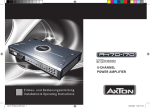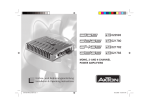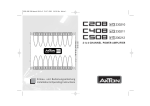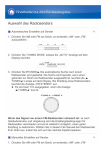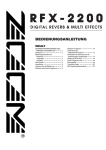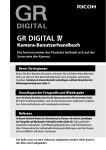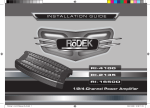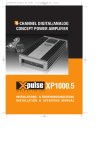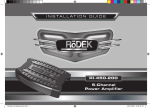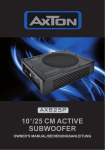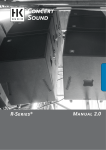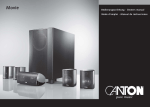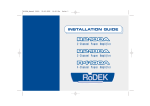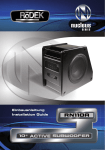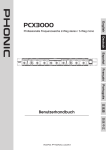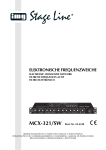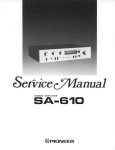Download 2 - ACR
Transcript
5-CHANNEL POWER AMPLIFIER Einbau- und Bedienungsanleitung Installation & Operating Instructions C609 Manual DE.indd 1 15.02.2005 10:33:57 Uhr Inhalt Einleitung . . . . . . . . . . . . . . . . . . . . . . . . . . . . . . . . . . . . . A B C D E F G H I J Seite 4 Allgemeine Merkmale . . . . . . . . . . . . . . . . . . . . . . . . . . 4 Anschlüße & Bedienungselemente C609. . . . . . . . . . .5/6 Montage-Tips . . . . . . . . . . . . . . . . . . . . . . . . . . . . . . . . 7 Verkabelungs-Tips . . . . . . . . . . . . . . . . . . . . . . . . . . . . . 7 Anschluß C609 . . . . . . . . . . . . . . . . . . . . . . . . . . . . . . . 9 Anschlußvarianten C609 . . . . . . . . . . . . . . . . . . . . 10/11 Einstellungen. . . . . . . . . . . . . . . . . . . . . . . . . . . . . . 12-14 Störungsbehebung . . . . . . . . . . . . . . . . . . . . . . . . . . . 15 Technische Daten . . . . . . . . . . . . . . . . . . . . . . . . . . . . 16 Garantiekarte . . . . . . . . . . . . . . . . . . . . . . . . . . . . 43/44 2 C609 Manual DE.indd 2 15.02.2005 10:34:00 Uhr Index Introduction . . . . . . . . . . . . . . . . . . . . . . . . . . . . . . . . . . A B C D E F G H I J Index Page 18 General Features . . . . . . . . . . . . . . . . . . . . . . . . . . . . . 18 Connections & Controls C609 . . . . . . . . . . . . . . . . . 19-20 Amplifier Location . . . . . . . . . . . . . . . . . . . . . . . . . . . . . 21 Wiring Tips. . . . . . . . . . . . . . . . . . . . . . . . . . . . . . . . . . . 21 Connecting the C609. . . . . . . . . . . . . . . . . . . . . . . . . . 23 Connecting Diagrams C609 . . . . . . . . . . . . . . . . . . 24-25 Controls and Adjustments . . . . . . . . . . . . . . . . . . . . . . . 26 Troubleshooting. . . . . . . . . . . . . . . . . . . . . . . . . . . . . . 29 Specifications . . . . . . . . . . . . . . . . . . . . . . . . . . . . . . . 30 Warranty Certificate . . . . . . . . . . . . . . . . . . . . . . . 43/44 Introduction . . . . . . . . . . . . . . . . . . . . . . . . . . . . . . . . . . . Page 32 A B C D E F G H I J Caractéristiques principales . . . . . . . . . . . . . . . . . . . . . 32 Connections et réglages C609 . . . . . . . . . . . . . . . . . . . 34 Placement de l’amplificateur. . . . . . . . . . . . . . . . . . . . . 35 Astuces de câblages . . . . . . . . . . . . . . . . . . . . . . . . . . . 35 Connecter le C609 . . . . . . . . . . . . . . . . . . . . . . . . . . . . 37 Connecting Diagrams C609 . . . . . . . . . . . . . . . . . . 24-25 Contrôles et réglages . . . . . . . . . . . . . . . . . . . . . . . . . . 38 défauts / solutions . . . . . . . . . . . . . . . . . . . . . . . . . . . . 40 Spécifications . . . . . . . . . . . . . . . . . . . . . . . . . . . . . . . . 41 Warranty Certificate . . . . . . . . . . . . . . . . . . . . . . . 43/44 3 C609 Manual DE.indd 3 15.02.2005 10:34:00 Uhr Einleitung Vielen Dank für das Vertrauen, das Sie uns mit dem Kauf dieses AXTONQualitätsprodukts entgegengebracht haben. Ob im Auto, Wohnmobil oder auf einem Boot, die AXTON Car Audio Verstärker wurden speziell für den Einsatz in mobilen Soundsystemen mit einer 12-Volt-Stromversorgung (mit negativer Chassis-Masse) entwickelt. Korrekt installiert, garantieren Ihnen die Axton-Verstärker in jedem Fall hervorragende Klangqualität. Damit Sie sich mit den technischen Eigenschaften und klanglichen Feinheiten Ihres Verstärkers vertraut machen können, empfehlen wir Ihnen, diese Einbau- und Bedienungsanleitung vor der Installation sorgfältig durchzulesen. Sollten beim Einbau oder bei den Einstellungen dennoch Fragen oder Probleme auftauchen, wenden Sie sich bitte an Ihren Axton-Händler. A ALLGEMEINE MERKMALE AXTON C609 ∑ 5-Kanal Endstufe zur Ansteuerung eines kompletten LautsprecherSystems mit Front- und Heck-Satelliten plus Subwoofer ∑ PWM MOSFET Schaltnetzteile mit hohem Wirkungsgrad ∑ A/B Endstufenschaltung mit BJT Transistoren (Bipolar Junction Transistors) ∑ Diskret aufgebaute Halbleiter-Endstufe ∑ 3 Paar Cinch-Eingänge (Front, Rear, Sub) ∑ Integrierte elektronische Hoch-/Tiefpaß-Filter mit 12dB/Oktave Flankensteilheit ∑ Subsonicfilter für Kanal 5 mit 20Hz / 12dB/Okt. ∑ Übergangsfrequenzen für Front- bzw. Heck-Satelliten und Subwoofer getrennt und stufenlos regelbar von 40-240 Hz ∑ Ein- /Ausschaltverzögerung ∑ Automatische Ein-/Ausschaltung über REMOTE-Leitung ∑ Umfangreiche Schutzschaltungen gegen Gleichspannung und Kurzschluß an den Lautsprecherausgängen sowie Überlastung bzw. Überhitzung des Verstärkers ∑ Variable Eingangsempfindlichkeit von 0.2 bis 9 V 4 C609 Manual DE.indd 4 15.02.2005 10:34:01 Uhr Anschlüße & Bedienungselemente Frontseite AXTON C609 1 14 2 5 6 8 4 7 Anschlüße & Bedienungselemente Rückseite AXTON C609 16 9 11 10 12 15 13 3 20 17 18 19 21 22 5 C609 Manual DE.indd 5 15.02.2005 10:34:01 Uhr B ANSCHLÜSSE UND BEDIENUNGSELEMENTE C609 1 INPUTS FRONT 1/2CH L+R Cinch-Eingangsbuchsen links und rechts zum Anschluß an die NF/Front-Pre-Out Signal-Ausgänge des Steuergerätes. 2 INPUTS REAR 3/4CH L+R Cinch-Eingangsbuchsen links und rechts zum, Anschluß an die NF/Rear-Pre-Out Signal-Ausgänge des Steuergerätes. 3 INPUTS SUB 5CH L+R Cinch-Eingangsbuchsen links und rechts zum Anschluß an die NF/Sub-Pre-Out Signal-Ausgänge des Steuergerätes. 4 HIGHPASS CH1/2 Schalter für die Frequenzweiche der Frontkanäle (CH1/2). Schalterstellung „Full“ bedeutet, Weiche ist deaktiviert. Schalterstellung „HPF“ heisst, Weiche ist aktiviert. 5 + 8 + 11 FRONT/REAR/SUB GAIN Getrennte Eingangsempfindlichkeitsregler für 3 Paar Eingänge (Front, Rear, Sub) zur individuellen Anpaßung der drei Verstärker-Sektionen an die Ausgangsspannung des Steuergerätes. 6 + 9 HIGHPASS FRONT+REAR Regler zum Einstellen der gewünschten Highpass-(HPF)/Übergangs- bzw. Trennfrequenzen für die beiden Satelliten-Paare (FRONT und REAR) zwischen 40 Hz und 240 Hz 7 HIGHPASS CH3/4 Schalter für die Frequenzweiche der 12 LOWPASS SUB Regler zum Einstellen der gewünschten Lowpass(LPF) / Übergangs- bzw. Trennfrequenz für den Subwoofer-Kanal (SUB) zwischen 40 Hz und 240 Hz. 13 SUBSONICFILTER Schalter für das Subsonicfilter des SubwooferKanals (5CH). Schalterstellung „OFF“ bedeutet, Subsonicfilter ist deaktiviert. Schalterstellung „ON“ heisst, Subsonicfilter ist aktiviert. 14 POWER LED Betriebszustands LED. Leuchtet grün, wenn die Endstufe eingeschaltet ist. 15 PROTECT LED Schutzschaltungs-LED. Leuchtet rot, wenn die Endstufe im Protect-Modus ist, z.B. bei Übertermperatur, Kurzschluss am Lautsprecherausgang oder Fehlfunktion. 16 FUSE Sicherungen für die interne Absicherung das Verstärkers gegen Überlastung und Fehlmanipulation. 17 +12 V Anschluß-Klemme für die direkte Verbindung zum positiven Batterie-Pol des Kfz. 18 REMOTE/REM Anschluß-Klemme für die automatische Ein- bzw. Ausschaltung des Verstärkers über den ‚Amp‘- oder ‚Antenna-Remote‘Anschluß Ihres Steuergerätes. 19 GROUND/GND Anschluß-Klemme für die Verbindung zur Chassis-Masse (-12V). 20 FRONT 팬 L 팫 und 팫 R 팬 Lautsprecher-Anschlußklemmen für das hintere Satelliten-Lautsprecher-Paar (Min. Impedanz 2 Ohm!). Rearkanäle (CH3/4). Schalterstellung „Full“ bedeutet, Weiche ist deaktiviert. Schalterstellung „HPF“ heisst, Weiche ist aktiviert. 21 REAR 팬 L 팫 und 팫 R 팬 Lautsprecher-Anschlußklemmen für das vordere Satelliten-Lautsprecher-Paar (Min. Impedanz 2 Ohm!). 10 LOWPASS CH5 Schalter für die Frequenzweiche der Subwoofer- 22 SUB 팬 L 팫 und 팫 R 팬 Lautsprecher-Anschlußklemmen für den Subwoofer (Min. Impedanz 4 bis 2 Ohm). Kanals (5CH). Schalterstellung „Full“ bedeutet, Weiche ist deaktiviert. Schalterstellung „LPF“ heisst, Weiche ist aktiviert. 6 C609 Manual DE.indd 6 15.02.2005 10:34:01 Uhr C MONTAGE-TIPS Die Plazierung Ihres Verstärkers hat einen großen Einfluß auf die Ableitung der im normalen Betrieb entstehenden Wärme bzw. auf das eventuelle Ansprechen der automatischen Überhitzungssicherung des Gerätes. Aufgrund der Wärmeentwicklung des Verstärkers sollten Sie einen gut belüfteten Installationsort auswählen. Ideal für die Langzeitstabilität Ihres Verstärkers ist grundsätzlich jeder Montageort, an dem Luft ungehindert an den Kühlrippen vorbeiziehen kann. 1 Die beste Kühlung erreichen Sie bei einem AXTON Verstärker, wenn Sie ihn hochkant, d.h. stehend montieren. D VERKABELUNGS-TIPS Generell gilt: falsche Verdrahtung bzw. falsche Anschlüße können sowohl Ihren Verstärker als auch andere, damit verbundene Audio-Komponenten beschädigen. Beachten Sie deshalb unbedingt die Anschlußhinweise in dieser Bedienungsanleitung. Die Kabelführung in Ihrem Fahrzeug hat einen erheblichen Einfluß auf das störungsfreie Funktionieren ihres Verstärkers bzw. der daran angeschlossenen Komponenten. Die folgenden allgemeinen Einbauhinweise sind dazu gedacht, Ihnen zu einer einfachen, korrekten und problemlosen Installation Ihres Verstärkers zu verhelfen. Einzelheiten zu den verschiedenen Ein- und Ausgängen bzw. den besonderen Einstellungsmöglichkeiten finden Sie in Abschnitten B, E, F und G dieser Anleitung. Da der Verstärker für seinen normalen Betrieb keinerlei Bedienungselemente aufweist, kann er z.B. gut unter einem Sitz oder im Kofferraum montiert werden. Wählen Sie für etwaige Einstellungsarbeiten dennoch einen bequem zugänglichen, ausreichend belüfteten Platz. Der Verstärker darf jedoch keinesfalls übermäßigem Staub, direktem Sonnenlicht, Feuchtigkeit, Wasser, Öl oder anderen Flüssigkeiten, die in das Geräteinnere eindringen können, ausgesetzt werden. Für die Audio-Signal-Verbindungen zwischen Steuergerät und Endverstärker sollten Sie nur doppelt oder dreifach abgeschirmte Qualitäts-Cinch-Kabel verwenden). Der Verstärker sollte auf einem soliden, vibrationsfreien Untergrund montiert werden. Haben Sie einen passenden Ort gefunden, verwenden Sie den Verstärker als Schablone zur Markierung der Montagelöcher. ™ Lautsprecher- und Stromkabel lassen sich problemlos auf die benötigten Längen konfektionieren. 2 Bohren Sie die vier Schraubenlöcher vor und schrauben Sie das Gerät mit den mitgelieferten Schrauben fest. Achten Sie darauf, dass der Verstärker nicht in Kontakt mit Metallteilen des Fahrzeugs kommt (Brummschleife!). 3 1 2 Halten Sie die Kabel immer so kurz wie möglich. Dies gilt besonders für die Strom- und die Signalkabel: ™ Abgeschirmte Cinch/Signal-Kabel sollten nie zerschnitten und wieder zusammengesetzt werden, da an den Schnittstellen der Abschirmungsschutz verloren geht. Falls ein Signal-Kabel zu lang sein sollte, verlegen Sie es mit einer S-förmigen Schleife (keine Rund- bzw. Spiralschleife) in der Kabelmitte. 3 Cinch-/Signal-Kabel sollten nie neben oder parallel zu Lautsprecher-, Zündungs- oder Stromkabeln verlegt werden. 7 C609 Manual DE.indd 7 15.02.2005 10:34:02 Uhr Verwenden Sie die empfohlenen Stromkabelquerschnitte (siehe E). Zu geringe Querschnitte verringern die Ausgangsleistung, bewirken Verzerrungen und evtl. zu frühes Ansprechen der Übertemperatur-Sicherung. 4 Sichern Sie die +12V-Hauptleitung von der Batterie zum Verstärker ca. 20-30 cm nach der Batterie mit einer Hauptsicherung ab und verwenden Sie unbedingt Stromkabel mit leistungsbezogenem Querschnitt (Einzelheiten dazu finden Sie unter Abschnitt F: Anschluß und Einstellungen). 5 Die -12V/Masse-Leitung sollte unbedingt denselben Querschnitt wie das +12V-Kabel haben! Achten Sie unbedingt auf guten Masse-Kontakt. Schlechte Masse-Kontakte sind die Ursache für die meisten Probleme. 6 Beachten Sie beim Verlegen der Kabel, daß keine Kurzschlüße mit dem Fahrzeugchassis entstehen. Verwenden Sie überall dort, wo Kabel durch Blech- bzw. Metallteile des Fahrzeugs hindurchgeführt werden müssen, passende Gummi-Tüllen. 7 Wichtig: Um Kurzschlüßen vorzubeugen, sollten Sie vor sämtlichen Installations- oder Verdrahtungsarbeiten immer den Plus-(+)-Pol der Batterie von der Stromversorgung des Fahrzeugs abtrennen. Machen Sie sich zur Regel: Erst nach Beendigung und Überprüfung aller anderen Installationsschritte wird die Verbindung zwischen dem +12VAnschluß der Batterie und dem Bordstromnetz wiederhergestellt. 8 C609 Manual DE.indd 8 15.02.2005 10:34:02 Uhr E ANSCHLUSS C609 ACHTUNG: DAS +12V KABEL MUSS VOR BEGINN DER ANSCHLUSSARBEITEN UNBEDINGT VOM PLUSPOL DER BATTERIE ENTFERNT WERDEN! Der empfohlene Stromkabel-Querschnitt für +12V und Masse (bei ca. 5 Meter +12V Kabel) beträgt bei der AXTON C609 20mm2. Die Hauptsicherung bei der Fahrzeugbatterie sollte bei diesem Verstärker ca. 60 A betragen. Idealerweise werden die Anschlüße in dieser Reihenfolge durchgeführt: 1 2 Das Steuergerät muss ausgeschaltet und der Lautstärke-Regler ganz zurückgedreht sein. Cinch Ausgänge vom Steuergerät mit entsprechenden Eingängen am Verstärker verbinden (beachten Sie auch die Anschluß-Diagramme auf den Seiten 10-11). Sub Pre-Outs vom Steuergerät sollten Vollbereichs Signale (FullrangeSignale) sein, da Tiefpass Sub-Ausgänge vom Vorverstärker immer die Filter-Elektronik des Verstärkers beeinträchtigen. Im Zweifelsfall oder beim Fehlen eines Sub Pre-Outs ‚verdoppeln‘ Sie einfach ein Vollbereichs-Pre-Out-Signal (wie etwa den Front- oder Rear-Ausgang des Steuergeräts) mit Hilfe von zwei Y-Adaptern. 3 4 Remote Schaltleitung vom Steuergerät zum Verstärker Lautsprecher-Kabel zu den entsprechenden Lautsprechern oder Passiv-Weichen. Achten Sie auf korrekte Polarität! Immer „팬“ auf „팬“ und „팫“ auf „팫“. Die Minimum-lmpedanz für jeden angeschlossenen Lautsprecher darf 2 Ohm nicht unterschreiten!!! GND/Masse-Verbindung zum Chassis oder direkt an den -12V Batterie-Pol. Wenn möglich, Masse-Kabel sehr kurz halten und sicherstellen, daß der Masse-Kontakt optimal leitet, d.h. Farbe, Rost oder Schmutz muß vor dem Anschluß gründlich vom Fahrzeugblech entfernt werden. Wenn Probleme auftauchen sollten, den „GND/GROUND“-Anschluß des Verstärkers direkt mit dem Minus-Pol der Batterie verbinden. 5 +12V direkt mit dem Plus-Pol der Batterie verbinden. Nicht vergessen innerhalb von 30 cm nach der Batterie eine Hauptsicherung zu installieren (Kabelbrand-Gefahr)!!! Vorschrift der Kfz.-Versicherer. 6 Schließen Sie den Stromkreis nicht, bevor Sie nochmals sämtliche Verbindungen und Anschlüße aberprüft haben! Schalten Sie Ihr Steuergerät ein, Lautstärke auf Minimum. Jetzt muß die grüne Status-LED auf der Frontseite des Verstärkergehäuses aufleuchten. Wenn nicht, Gerät sofort wieder ausschalten und die Installation auf fehlende oder fehlerhafte Anschlüße überprüfen. 9 C609 Manual DE.indd 9 15.02.2005 10:34:02 Uhr Wichtig! • Min. Impedanz für alle Lautsprecher-Ausgänge 2 Ohm! • SUB-Eingangssignal sollte ein Vollbereichs-/ Fullrange-Signal sein! • Eine Hauptsicherung von 60 A muß innerhalb 30 cm von der Batterie eingebaut werden! F ANSCHLUSS-VARIANTE mit 3 x PRE-OUT 10 C609 Manual DE.indd 10 15.02.2005 10:34:02 Uhr Wichtig! • Min. Impedanz für alle Lautsprecher-Ausgänge 4 Ohm! • Eine Hauptsicherung von 60 A muß innerhalb 30 cm von der Batterie eingebaut werden! F ANSCHLUSS-VARIANTE mit 2 x PRE-OUT 11 C609 Manual DE.indd 11 15.02.2005 10:34:03 Uhr G EINSTELLUNGEN C609 System-Verstärker-Konzept Die AXTON C609 ist eine 5-Kanal Endstufe. Mit einer einzigen C609 läßt sich auf einbaufreundliche Weise ein komplettes und klangstarkes 5-kanaliges Lautsprechersystem mit zwei Paar Stereo-Satelliten (vorn und hinten) und einem Mono-Subwoofer ansteuern. Die individuell, regelbaren integrierten Hochpass- bzw. Tiefpass-Filter der C609 erlauben es, die eingesetzten Lautsprecher genau den Einsatzbereich zuzuteilen, für den sie am besten geeignet sind. Die bassschwachen Satelliten arbeiten bei der C609 nur im Midbassund Mittel-Hochtonbereich, wodurch sie einerseits mechanisch und elektrisch weniger belastet werden, was sich andererseits in einer höheren Pegelfestigkeit niederschlägt. Der weder für Mittel- noch für Hochton geeignete Subwoofer verarbeitet nur Bass- und Tiefbass-Signale und kann dadurch nicht das Klangbild im Mittelhochtonbereich verfärben. 1 TRENNFREQUENZ-EINSTELLUNGEN HIGHPASS FRONT und REAR, LOWPASS SUB Bevor die Eingangsempfindlichkeiten (GAIN) angepaßt werden können, müssen zunächst die Trennfrequenzen aller Lautsprecher eingestellt werden. Alle diese Frequenz-Einstellungen sollten grundsätzlich gehörmäßig gemacht werden! Bringen Sie vor der Trennfrequenz-Einstellung alle Klangregler (Bass, Mid, Treble und evtl. Sub) am Steuergerät sowie Fader und Balance in ihre Neutral- bzw. Mittelstellung. Auch die LoudnessFunktion sollte während den Einstellungen ausgeschaltet sein. Mit der Einstellung des Hochpass-Filters (HPF) der Satelliten-Lautsprecher an den HIGHPASS FRONT/REAR Reglern soll eine elektrische und mechanische Entlastung der eingesetzten Koax- oder Kompo-Systeme erreicht werden. Je nach vorhandener Membranfläche und Nennbelastbarkeit der Lautsprecher empfiehlt sich eine Einsatz- bzw. Trennfrequenz zwischen 40 und 240 Hz. Eine zu tief gewählte Einsatz- bzw. Trennfrequenz bringt eine gute Midbass-Wiedergabe, schränkt aber gleichzeitig die Pegelfestigkeit ein. Eine zu hohe Einsatz- bzw. Trennfrequenz erbringt eine gute Pegelfestigkeit, macht aber auch den Klang ‚dünner‘. Als Anhaltspunkte für die richtige HPF/HIGHPASS Trennfrequenzwahl der Satelliten finden Sie untenstehend einige praxiserprobte Richtwerte für die gängigsten Armaturenbrett-, Tür- und HeckablagenLautsprecher: Front-Satelliten-Systeme 10 cm Ø Koax oder 2-Weg-Kompos 13 cm Ø Koax oder 2-Weg-Kompos 16 cm Ø Koax oder 2/3-Weg-Kompos HIGHPASS FREQ. 90-120 Hz 80-100 Hz 70 - 80 Hz Heck-Satelliten-Systeme 10 cm Ø Koax oder 2-Weg-Kompos 13 cm Ø Koax oder 2-Weg-Kompos 16 cm Ø Koax oder 2/3-Weg-Kompos HIGHPASS FREQ. 100-150 Hz 120-130 Hz 100-130 Hz 12 C609 Manual DE.indd 12 15.02.2005 10:34:03 Uhr Satelliten-Grundregel 1 Das klanglich hochwertigere Satelliten-System sollte immer vorne eingebaut werden. und System2 Empfindlichkeits-Anpassung Abgleich LEVEL FRONT, REAR und SUB Satelliten-Grundregel 2 Ausgehend von ungefähr gleichen Durchmessern und gleicher Bauart des Front- und Heck-LautsprecherSystems sollte die Trennfrequenz der Front-Satelliten wennmöglich immer tiefer liegen als die der HeckSatelliten! Die richtige Eingangsempfindlichkeits-Einstellung ist wichtig für die Erreichung des optimalen Dynamikspielraumes Ihrer gesamten CarAudio-Anlage. Nicht optimale Anpassungen haben entweder einen überhöhten Rauschanteil oder verminderte Maximallautstärke oder unnötige Verzerrungen zur Folge. Es empfiehlt sich die GAIN-Einstellungen in der nachstehenden Reihenfolge vorzunehmen: Die zu wählende LOWPASS / LPF-Tiefpass-Trennfrequenz des Subwoofers sollte normalerweise im Bereich zwischen 50 und 90 Hz liegen. Stellen Sie den LOWPASS FREQ. Regler so ein, daß der Klang im Baßbereich satt und trocken mit ausreichend Tiefbass-Anteil wiedergegeben wird. ™ Bringen Sie alle Klangregler (Bass, Mid, Treble und evtl. Sub) am Steuergerät sowie Fader und Balance in ihre Neutral- bzw. Mittelstellung. Auch die Loudness-Funktion sollte während den Einstellungen ausgeschaltet sein. Subwoofer-Grundregel Eine zu tiefe LPF-Trennfrequenz läßt den Bass-Bereich kraft- und kontrastlos wirken. Bei einer zu hohen Trennfrequenz tendiert der Bass zum Dröhnen. ™ Drehen Sie alle 3 GAIN-Regler der C609 auf ihre Minimumpositionen. Durch ein Auseinanderlegen der HPF-/Hochpass-Einsatzfrequenzen der Satelliten und der LPF/Tiefpass-Trennfrequenz kann der allgemeinen DröhnNeigung der meisten PKWs im Bereich um 100 Hz entgegengewirkt werden. ™ Nun drehen Sie den SUB GAIN Regler langsam im Uhrzeigersinn auf, bis deutliche Verzerrungen im Baßbereich zu hören sind. Drehen Sie den Regler gerade soweit zurück, bis die Verzerrungen wieder verschwunden sind. Hochpass/TiefpassSystem-Tip ™ Schalten Sie das Steuergerät ein und drehen Sie die Lautstärkeregelung ca. 3/4 auf. Setzen Sie für die folgenden Einstellungen ein gut aufgenommenes, dynamikreiches Musikstück ein. ™ Jetzt drehen Sie die Lautstärke am Steuergerät auf ein mittleres Maß zurück. 13 C609 Manual DE.indd 13 15.02.2005 10:34:03 Uhr ™ Drehen Sie nun den GAIN FRONT Regler Ihres Verstärkers langsam im Uhrzeigersinn auf, bis Sie einen tonal ausgewogenen Klangcharakter erzielt haben. Eine leichte Baßbetonung ist vorzuziehen, da sie von den Fahrgeräuschen wieder „überdeckt‘ wird. ™ Drehen Sie nun den GAIN REAR Regler langsam auf, bis Sie mit den Heck-Lautsprechern einen guten ‚Rear-Fill‘ und ein homogenes Gesamtklangbild erreicht haben. ™ Abschließend empfiehlt sich eventuell ein Fine-Tuning der eingestellten Hoch- und Tiefpassfrequenzen, wobei Sie mit der Nachregelung der Subwoofer-Trennfrequenz (LOWPASS SUB) beginnen sollten. Danach werden u.U. noch die Front-Satelliten (HIGHPASS FRONT) und zum Schluß die Heck-Satelliten (HIGHPASS REAR) fein-eingestellt. WICHTIG: Die in diesem Abschnitt erwähnten Einstellungshinweise setzen voraus, daß Sie mit den Anforderungen und Möglichkeiten der angeschlossenen Audio-Komponenten (v.a. Steuergerät und Lautsprecher) eingehend vertraut sind! 14 C609 Manual DE.indd 14 15.02.2005 10:34:03 Uhr H STÖRUNGSBEHEBUNG Problem Ursache Kein Musiksignal auf den Lautsprechern und Power-LED leuchtet nicht grün ● ● ● ● ● ● ● ● + 12 V oder GROUND (Masse) oder “Remote“-Kabel nicht (richtig) angeschlossen Sicherung des Verstärkers durchgebrannt Hauptsicherung an der Batterie durchgebrannt Kurzschluß auf einem der Lautsprecherausgänge DC/Gleichspannung am Ausgang Überlastung des Verstärkers Überhitzung des Verstärkers Ein Sirren das mit der Motordrehzahl zu- oder abnimmt ● ● Schlechter Masseanschluß des Verstärkers oder des Steuergerätes Schlecht geschirmte Cinchleitungen und- oder schlecht gewählte Cinchkabelführung (induktive Einstreuungen der Bordelektrik) Prasseln in Abhängigkeit der Motordrehzahl ● Schlecht entstörte Zündanlage Störgeräusche ● Deutet auf eine Masseschleife (doppelter Masseanschluß) hin. Bei der Montage des Verstärkers Kontakt zur Kfz. Masse vermeiden Überprüfen Sie auch die Masse-Verbindungen der anderen angeschlossenen Audio-Geräte ● Wichtig! Die Schutzschaltung schaltet den Verstärker bei Kurzschluß, Überlastung, Überhitzung oder DC/Gleichspannung am Ausgang ab. Wenn die Fehlerursache behoben ist, läuft die Endstufe wieder normal (LED an); ansonsten schaltet der Verstärker immer wieder an und aus. 15 C609 Manual DE.indd 15 15.02.2005 10:34:04 Uhr I TECHNISCHE DATEN AXTON 5-Kanal System Verstärker Sinusleistung mono/stereo (an 13.8V) Satelliten (Front+Rear) an 4 Ohm (2 x stereo) min. Subwoofer (mono) an 4 Ohm min. Sinusleistung mono/stereo (an 13.8V) Satelliten (Front+Rear) an 2 Ohm (2 x stereo) Subwoofer (mono) an 2 Ohm Frequenzgang (Sub+Front+Rear) Verzerrungen/Klirr (THD) an 4 Ohm Rauschabstand Kanaltrennung Flankensteilheit Hochpass und Tiefpass Regelbereich Hochpass Regelbereich Tiefpass Empf. Stromkabel-Querschnitt bei ca. 5 m Kabellänge Eingangsimpedanz Max. Eingangsempfindlichkeit Dämpfungsfaktor Thermische Sicherung Sicherung Empf. Hauptsicherung batterie-seitig bei 20 mm2 Stromkabel Abmessungen (L x H x B) mm Technische Änderungen vorbehalten C609 4 x 50 W RMS 1 x 150 W RMS 4 x 70 W 1 x 220 W RMS 10 - 30.000 Hz < 0.05 % > 95 dB > 55 dB 12 dB/oct. 40 - 240 Hz 40 - 240 Hz 20 mm2 47 k Ohm 0.2 - 9 V > 250@ 4 Ohm 85 °C 3 x 25 A 60 A 410 x 53 x 256 mm AXTON ist eine eingetragene Handelsmarke der ACR AG, Bohrturmweg 1, CH-5330 Zurzach, Switzerland. 16 C609 Manual DE.indd 16 15.02.2005 10:34:04 Uhr 17 C609 Manual DE.indd 17 15.02.2005 10:34:04 Uhr Introduction Thank you for purchasing this AXTON quality audio component. The AXTON automotive amplifier series has been developed for the use with mobile sound systems using 12 Volts negative ground power supply. The amplifiers may be used in combination with almost any brand and type of head unit and speakers in cars, vans, boats etc., when installed correctly, this amplifier will produce exceptional sound results. In order to familiarize yourself with all the special features and controlling options of your brandnew power amplifier, we advise you to read these instructions carefully before starting with the actual installation. A GENERAL FEATURES ∑ 5-Channel amplifier for powering a complete car audio speaker system with front and rear satellites plus subwoofer ∑ PWM MOSFET high efficiency switching power supply ∑ A/B amplification technology with dedicated BJT transistors (Bipolar Junction Transistors) ∑ Discrete solid state layout ∑ 3 pairs of RCA inputs (Front, Rear, Sub) Should you have any difficulty in installing this amplifier in your vehicle, please contact your nearest AXTON dealer. ∑ Integrated active high-/low pass filtering with 12 dB/oct. cutting slope ∑ Subsonicfilter for channel 5CH 20Hz / 12dB/oct. ∑ Crossover frequencies independently adjustable for front and rear satellites and subwoofer channel from 40-240 Hz ∑ Soft start and turn-off delay circuit ∑ Automatic on/off via remote switching from head-units. ∑ Protection circuitry against D.C. offset and shortcircuits at speaker outputs as well as amplifier overload or overheat ∑ Input level/gain adjustable from 0.2 to 9 V 18 C609 Manual DE.indd 18 15.02.2005 10:34:04 Uhr Connections & Controls Front Panel AXTON C609 14 1 2 5 6 8 4 9 7 Connections & Controls Rear Panel AXTON C609 11 10 12 15 13 3 20 16 17 18 19 21 22 19 C609 Manual DE.indd 19 15.02.2005 10:34:04 Uhr B CONNECTIONS AND CONTROLS C609 1 INPUTS FRONT 1/2CH L+R Low-level RCA signal input for connection to the head-unit front pre-out. 12 LOWPASS SUB Lowpass filter frequency control for the subwoofer channel allowing the setting of the respective lowpass cut-off frequencies between 40 and 240 Hz. 13 SUBSONICFILTER Activates, resp. deactivates the subsonic filter of the sub channel. 2 INPUTS REAR 3/4CH L+R Low-level RCA signal input for connection to the head-unit rear pre-out. 14 POWER LED Amplifier status-LED, signalling normal operation (green). 3 INPUTS SUB 5CH L+R Low-Level RCA signal input for connection to the head-unit sub pre-out or - if not available - to the ‚doubled‘ rear pre-out (using a pair of Y-adaptors). 4 HIGHPASS 1CH/2CH Operating mode switch, activates the highpass filter of the front channels. 5 + 8 + 11 FRONT/REAR/SUB/GAIN Separate input gain/sensitivity controls for all 3 input sections allowing the individual matching of the amplifier sections to the respective head-unit (pre-out) output voltages. 6 + 9 HIGHPASS FRONT+REAR Highpass filter frequency controls for the front and rear satellites allowing the setting of the respective highpass cut-in frequencies between 40 and 240 Hz. 7 HIGHPASS 3CH/4CH Operating mode switch, activates the highpass filter of the rear channels. 10 LOWPASS CH5 Operating mode switch, activates the lowpass filter of the sub channel. 15 PROTECT LED Protect mode LED, signalling amplifier malfunction when lit red, due to shorted speakers, overtemperature etc. 16 FUSE Fuse for protection of the amplifier-internal electronics against overload or faulty operation / wrong manipulation. 17 +12 V Power connection terminal to positive terminal of car battery. 18 REMOTE/REM Remote switching contact for the automatic (remote) turn-on / turn-off of the power amplifier from the head-unit‘s remote (or antenna control) lead. 19 GROUND/GND Power connection terminal to chassis ground or negative terminal of car battery (-12V). 20 FRONT 팬 L 팫 und 팫 R 팬 Speaker output terminals for the front satellite speaker pair (min. impedance 2 Ohms!). 21 REAR 팬 L 팫 und 팫 R 팬 Speaker output terminals for the rear satellite speaker pair (min. impedance 2 Ohms!). 22 SUB 팬 L 팫 und 팫 R 팬 Speaker output terminals for the subwoofer (min. impedance 4 - 2 Ohms!) 20 C609 Manual DE.indd 20 15.02.2005 10:34:05 Uhr C AMPLIFIER LOCATION The mounting location of the power amplifier will have a large effect both on its ability to dissipate the heat generated during normal operation through the heat sink and on the possible triggering of its protective internal overheat protection circuit. Any mounting position allowing for a good air stream across the cooling fins of the amplifiers heatsink will improve cooling and long-term stability dramatically. 1 With the AXTON amplifier series the most efficient ventilation is achieved when the units are installed standing up! Therefore select a suitable location that is convenient for mounting and accessible for wiring and offers sufficient ventilation for cooling. As your amplifier features no controls for normal operation, it may be mounted away from the dashboard, i.e. under a car seat or in the trunk. However, make sure the unit is not exposed to excessive dust, direct sunlight, humidity, water, oil or other fluids that may enter the amplifier. D WIRING TIPS Please note: wrong power or signal connections may damage the amplifier and other components connected to it. Therefore, please read this manual carefully before the connection of any power, signal and speaker leads is done. The wire routing is critical for noise-free performance. For best results, please follow the general wiring guidelines listed below (for details see sections B, E, F and G of this manual). 1 2 3 Secure the amplifier using the four screws. Avoids to let the amplifier get in contact with metal parts of the vehicle. This helps to eliminate unwanted ground loops. 4 3 Signal, speaker and power cables should always be kept as short as possible: ™ Speaker and power cables may be cut to fit the actual lengths required. ™ Shielded RCA/signal cables should never be cut and respliced, as they will loose their protective shielding effect in the places where they are cut. If the signal cable is too long, make an S-type loop (never a coil loop) about midway of the cable stretch. The amplifier should be mounted to a solid surface that will ensure a vibration-free mount. Once selected, use the unit as a template for the marking of the mounting holes which should also be pilot-drilled before final installation with the provided screws is carried out. 2 For audio signal connections you should always use double or triple shielded quality RCA cables. Never route any low level/signal cable near or parallel to speaker outputs/speaker cables, amplifier power cables or high energy ignition wires. Use power cable with the recommended cross section (see section E). Small cross sections are reducing the output power, are causing distortions and may be triggering the overheat protection of the amplifier. 21 C609 Manual DE.indd 21 15.02.2005 10:34:05 Uhr Make sure you are using a main fuse protection for the +12V-power input of the amplifier within max. 30 cm of the car battery and power cables with an amperage adequate cross-section and main fuse (for details see section E: „Connecting“). 5 The GROUND/GND cable (-12V) should have the same crosssection as the +12V power cable. Make sure to get a good chassis ground contact, because poor ground contacts are the cause for most power problems with car audio installations. 6 Make sure no power, signal or speaker lines are shorting to chassis ground by using rubber grommets wherever a cable has to pass through any metal part of the vehicle. 7 Important: Before any wiring, always remove the (+) terminal of the battery to prevent short-circuiting. The last lead to be connected in every installation is always the positive (+) 12 Volt terminal of the battery. Connect this lead only after having completed and checked all other connections. 22 C609 Manual DE.indd 22 15.02.2005 10:34:05 Uhr E CONNECTING THE C609 IMPORTANT: DISCONNECT THE +12V MAIN POWER CABLE FROM YOUR CAR BATTERY BEFORE ANY CONNECTING WORK IS CARRIED OUT! The recommended power cable cross-section for +12 V (average length 5 m) and ground cable is 20 mm2! The recommended main fuse value for this amplifier is 60 A! It is recommended to connect your amplifier as follows: 1 2 Make sure your head-unit is turned off and the volume control is in its minimum position. RCA outputs of your head unit to respective RCA inputs of your amplifier (see connecting diagrams on pages 23 - 24 of this manual). Sub pre-outs from head-unit should be fullrange signals because lowpass pre-out signals always affect filtering electronics of amplifier! In case of doubt just ‚double‘ a fullrange front or rear pre-out by using Y-adaptors. 3 4 Remote lead connection from head-unit to amplifier. Speaker cables to respective speakers or passive crossovers. Make sure to keep correct polarity! „팬“ to „팬“ and „팫“ to „팫“ All speakers must have a minimum impedance of 2 Ohms!!! Ground connection to chassis ground or -12 V negative battery: If possible ground cable as short as possible and make sure chassis contact is well sand-papered, i.e. clean from any paint, rust or dirt for maximum contact. In case of problems hook-up your your annplifier directly with the -12 V negative pole or your battery. 5 6 +12 V power connection to positive battery pole. Do not forget to install a main fuse within 30 cm of car battery (fire hazards)!!! Do not connect +12 V cable to battery before re-checking every other connection on the amplifier! Turn-on your head-unit keeping your volume at the minimum. The green status LED on the front of the amplifier should light up now. If not, turn-off your head-unit and recheck all wiring to and from the amplifier for missing or faulty connections. 23 C609 Manual DE.indd 23 15.02.2005 10:34:05 Uhr PLEASE NOTE! • Min. Impedance for all speaker is 2 Ohms! • SUB-input signal should be a fullrange signal! • A main fuse 60 A must be installed 30 cm within of car battery! F CONNECTING DIAGRAM 3 x PRE-OUT 24 C609 Manual DE.indd 24 15.02.2005 10:34:06 Uhr PLEASE NOTE! • Min. Impedance for all speaker is 4 Ohms! • A main fuse 60 A must be installed within 30 cm of car battery! F CONNECTING DIAGRAM 2 x PRE-OUT 25 C609 Manual DE.indd 25 15.02.2005 10:34:06 Uhr G CONTROLS & ADJUSTMENTS C609 5-Channel System Amplifier The AXTON C609 is a powerful 5-channel system amplifier. One single C609 allows for an easy-to-install, speaker-dedicated amplification of a complete 5-channel speaker system, i.e. with two stereo pairs of independently controlled satellite speakers (front and rear) and one mono subwoofer. The integrated, separately adjustable HIGHPASS and LOWPASS crossover filters of the C609 enable you to drive the connected speakers in the specific frequency range where they will perform best. Dashboard, door and rear shelf speakers of 10-16cm diameter will never have a good low-end bass reproduction anyway. Therefore the C609 front and rear satellite channels will only be playing in the midbass and mid/high frequency range. This so-called highpass filtered or HPF amplification mode aIso puts less electrical and mechanical ‚strain‘ on the speaker units, resulting in an increased power handling capacity. The subwoofer output will only receive lowpass filtered (LPF) signals resulting in the subwoofer only playing in the low-end bass frequency range without any unwanted‚ booming‘ into the mid/high frequencies. CROSSOVER FREQUENCY SETTINGS 1 HIGHPASS FRONT & REAR, LOWPASS SUB For appropriate crossover frequency selection, all tone controls (Bass, Mid, Treble, Sub) and all fader and balance controls etc. on the head unit have to be brought to their neutral or center position! The „Loudness” function should also be deactivated. Depending on the actual cone surface area, voice-coil diameter and the rated power handling of the ‚satellites‘ it is recommended to set the high-pass crossover / cut-in frequency between 40 and 240 Hz. If the satellite highpass frequency is set too low, the mid-bass reproduction will be increased, but at the same time the power handling capacity of the satellites will decrease. If the highpass frequency is set too high, the mid-bass reproduction will become ‚thinner‘ while the power-handling capacity of the satellites will increase. As a general guideline, below you find a practice-proven list for appropriate satellite HPF crossover / cut-in frequencies covering the most widely used dashboard, door and rear-shelf speaker diameters: Front Satellite Speakers 10 cm Ø Coaxials or 2-Way Compos 13 cm Ø Coaxials or 2-Way Compos 16 cm Ø Coaxials or 2/3-Way Compos HIGHPASS FREQ. 90-120 Hz 80-100 Hz 70 - 80 Hz Rear Satellite Speakers 10 cm Ø Coaxials or 2-Way Compos 13 cm Ø Coaxials or 2-Way Compos 16 cm Ø Coaxials or 2/3-Way Compos HIGHPASS FREQ. 100-150 Hz 120-130 Hz 100-130 Hz Before you can effect the respective input sensitivity or gain LEVELs you first have to select the system appropriate crossover frequencies. For best results all crossover adjustments should usually be effected by ear. 26 C609 Manual DE.indd 26 15.02.2005 10:34:06 Uhr Satellite rule 1 The better sounding satellite system should always be installed in the front of the vehicle. Adjustments and System Matching 2 Sensitivity GAIN FRONT, REAR and SUB Satellite rule 2 Based on identical speaker diameters and comparable engineering quality of the front and rear satellites, the crossover cut-in frequency of the front satellites should usually be set lower than the highpass frequency of the rear satellites. To reach a maximum of dynamic response from your individual head unit / amplifier / speaker combination, it is important to set the respective input sensitivity controls (LEVEL) correctly. On the one hand the sensitivity determines the actual signal-to-noise ratio. On the other hand the sensitivity also controls the maximum distortion-free sound pressure level (SPL) possible with your specific car audio system. The LPF / LOWPASS SUB cut-off frequency for the subwoofer should usually be set in between 50 and 90 Hz. Adjust the LOWPASS SUB control in such a way that the bass reproduction will be precise and rich, while still delivering a good and solid low-end bass. Subwoofer guideline Generally, setting the LPF lowpass cut-off frequency too low will result in a weak and uncontoured bass response. Setting the LPF control too high tends to give the subwoofer a ‚booming‘ sound. High- & lowpass system tip When selecting the high- and lowpass frequencies of a sound system, it is recommended to ‚leave a gap‘ between the subwoofer LPF cut-off frequency and the satellite HPF cut-in frequencies. Such a ‚gap‘ between the LPF and HPF settings can be helpful to compensate for much of the midbass resonance (around 100 Hz) otherwise occuring in most vehicle environments. It is recommended to effect the sensitivity adjustments and system GAIN matching in the same sequence as listed below: ™ Set all tone controls (Bass, Mid, Treble, Sub) on the head-unit as well as all fader and balance controls to neutral. The „Loudness“ option should be in the „Off“ position, too. ™ Set all 3 GAIN controls of the C609 to their lowest position. ™ Turn-on your head-unit and turn-up the volume control to approximately 3/4 of full volume and start playing a well recorded, dynamic piece of music. ™ Slowly turn up the GAIN control of 5CH until you can just hear distorted bass sounds. Slowly decrease the GAIN SUB control to the point where the distortions have disappeared. ™ Now you reduce the main volume level on the head-unit to a medium listening level. ™ Start turning up the FRONT GAIN control (1CH/2CH) clockwise until you have reached a good tonal balance between the front satellites and the subwoofer. A slight attenuation of the bass range should be preferred, as this will be compensated by normal driving noises. 27 C609 Manual DE.indd 27 15.02.2005 10:34:06 Uhr ™ Start turning up the REAR GAIN control (3CH/4CH) clockwise until you feel to you have reached an appropriate ‚rear fill‘ in the back of the car, so that the overall in-car sound becomes smooth and homogenous. ™ Finally, you may want to do some fine-tuning on the different highpass and lowpass frequencies selected. It is recommended to start fine-tuning with the subwoofer (LOWPASS SUB) frequency. Proceed - if necessary - with the front satellites (HIGH-PASS FRONT) and finish the frequency adjustments with the rear satellites (HIGHPASS REAR). IMPORTANT: All advice on controls and adjustments of this manual section is based on the assumption that you are also thouroughly acquainted with all the requirements and features of the entire audio equipment - especially the head-unit and the speakers - connected to this amplifier! 28 C609 Manual DE.indd 28 15.02.2005 10:34:07 Uhr H TROUBLESHOOTING Problem Cause No music signal on loudspeakers and POWER-LED on amp is off ● ● ● ● ● ● ● ● A high-pitched buzzing sound in- or decreasing with engine speed ● Bad ground (GND) conntact of amplifier or head unit /CD/MD-changer ● Insufficiently shielded RCA interconnects and/or bad RCA cable routing (inductive interference of on-board electronics) Crackling sound in- or decreasing with engine speed ● Insufficient interference elimination of ignition circuitry Humming ● Sign of ground loop(s), i.e. multiple ground connections of the car audio installation or parts there of. ● Check also ground connections of all other audio components conncected + 12 V and/or GROUND (GND/ -12V) and/or “Remote” line not (properly) connected Fuse on amplifier or distributor blown Main Fuse on car battery side blown Short-circuit on any of the speaker outputs DC voltage at speaker outputs Amplifier overload Amplifier overheat IMPORTANT! The amplifier’s protection circuitry will shut-off the amplifier in case of short-circuit, overload or DC offset at the speaker out-puts or in case of overheat. There will be an automatic re-start after approx. 5 sec. In case the cause for protection shut-off has been eliminated, the amplifier will operate normally again (LED on). Otherwise the amplifier will continue switching on and off. 29 C609 Manual DE.indd 29 15.02.2005 10:34:07 Uhr I SPECIFICATIONS AXTON 5-Channel System Amplifier Rated power output mono/stereo (at 13.8V) Satellites (Front+Rear) at 4 Ohms (2 x stereo) min. Subwoofer (mono) at 4 Ohms min. Rated power output mono/stereo (at 13.8V) Satellites (Front+Rear) at 2 Ohms (2 x stereo) Subwoofer (mono) at 2 Ohms Frequency response (Sub+Front+Rear) Total Harmonic Distortion (THD) at 4 Ohms Signal to noise ratio Channel separation Crossover slope highpass and lowpass Adjustable highpass frequency range Adjustable lowpass frequency range Recommended cross-section with 5m powercable Input impedance Input sensitivity Damping factor Thermal cut-off Fuse Recommended main fuse at car battery with 20 mm2 power cable Dimensions (W x H x L) Specifications subject to change without notice. C609 4 x 50 W RMS 1 x 150 W RMS 4 x 70 W 1 x 220 W 10 - 30.000 Hz < 0.05 % > 95 dB > 55 dB 12 dB/oct 40 - 240 Hz 40 - 240 Hz 20 mm2 47 k Ohms 0.2 - 9 V > 250@ 4 / 20Hz 85 °C 3 x 25 A 60 A 256 x 53 x 410 mm AXTON is a registred trademark of ACR AG, Bohrturmweg 1, CH-5330 Zurzach, Switzerland. 30 C609 Manual DE.indd 30 15.02.2005 10:34:07 Uhr 31 C609 Manual DE.indd 31 15.02.2005 10:34:07 Uhr Introduction Merci d’avoir acheté cet amplificateur AXTON Cette gamme d’amplificateurs a été spécialement développée pour une utilisation en milieu automobile utilisant une alimentation 12 v avec masse au châssis. Ces amplificateurs peuvent être utilisés en combinaison avec tout autre composants audio disponible sur le marché tant au niveau hautparleurs que sources. Installés correctement, les appareils AXTON vous procureront un niveau de reproduction sonore exceptionnelle. Afin de vous familiariser avec les possibilités et les réglages de votre amplificateur AXTON, nous vous conseillons de lire attentivement cette notice d’utilisation. Si vous rencontrez un quelconque problème, n’ hésitez pas à vous rapprocher de votre revendeur AXTON. A CARACTÉRISTIQUES PRINCIPALES ∑ Amplificateur 5 canaux pour amplifier un système complet satellites et subwoofer. ∑ Alimentation MOSFET hautes performances. ∑ Etages de sorties à transistors bipolaires en classe A/B. ∑ 3 paires d’entrées RCA. ∑ filtres actifs 12 dB/oct intégrés. ∑ filtrage subsonic 12dB/oct. intégré sur le canal 5. ∑ Fréquences de coupure des filtres indépendantes entre les canaux avant, arrière et subwoofer (40-240 Hz). ∑ Démarrage et arrêt de l’amplificateur temporisés. ∑ Circuits de protection contre les surchauffes, les court circuits et le courant continu en sortie. ∑ Input level/gain adjustable from 0.2 to 9 V ∑ Gain d’entrée ajustable entre 0.2 et 9 V 32 C609 Manual F 2 15.02.2005 10:43:24 Uhr Connections et réglages Face avant AXTON C609 14 1 2 5 6 8 4 9 7 Connections et réglages Face avant AXTON C609 11 10 12 15 13 3 20 16 17 18 19 21 22 33 C609 Manual F 3 15.02.2005 10:43:24 Uhr B CONNECTIONS ET RÉGLAGES C609 1 ENTRÉES AVANT: entrées RCA bas niveau à connecter à la 2 ENTRÉES ARRIÈRE: entrées RCA bas niveau à connecter à la source. 13 FILTRE SUBSONIC: active ou désactive le filtre subsonic sur le 14 INDICATEUR DE MISE EN MARCHE: ce voyant (vert) indique le bon fonctionnement de l’amplificateur. 3 ENTRÉES SUBWOOFER: entrées RCA bas niveau à connecter à la source. Si votre source ne dispose pas de sorties subwoofer, utilisez un Y rca sur les sorties arrières. 4 PASSE-HAUT CANAUX 1 & 2: active les filtres passe-haut sur les entrées 1 & 2. GAINS AVANT, ARRIÈRE ET SUBWOOFER: gains séparés afin d’ajuster au mieux les différents niveaux d’entrée aux niveaux de sortie de la source. 6 + 9 PASSE-HAUT AVANT ET ARRIÈRE: réglages des fréquences de coupure des filtres passe-haut pour les canaux avant et arrière. Réglage effectif entre 40 et 240 Hz. 7 PASSE-HAUT CANAUX 3 & 4: active les filtres passe-haut sur les entrées 3 & 4. 10 PASSE-BAS CANAL 5: active le filtre passe-bas sur le canal 5 (subwoofer). passe-bas de canal 5 (subwoofer). Réglage effectif entre 40 et 240 Hz. canal sub. source. 5 + 8 + 11 12 PASSE-BAS SUB: réglage de la fréquence de coupure du filtre 15 INDICATEUR DE MISE EN PROTECTION: ce voyant (rouge) indique que l’amplificateur a enclenché une de ces protections suite à un problème. 16 FUSIBLE: protége l’amplificateur contre les surcharges. 17 +12 V: à connecter à la borne positive de la batterie. 18 REMOTE: signal de mise en marche de l’amplificateur, à connecter à une sortie télécommandée de la source. 19 MASSE: à connecter au châssis du véhicule ou à la borne négative de la batterie. 20 SORTIES AVANT: bornier haut parleur avant. Impédance mini: 2 ohms 21 SORTIES ARRIÈRE: bornier haut parleur arrière. Impédance mini: 2 ohms 22 SORTIES SUBWOOFER: bornier haut parleur subwoofer. Impédance mini: 2 ohms stéréo ou 4 ohms bridgé. 34 C609 Manual F 4 15.02.2005 10:43:24 Uhr C PLACEMENT DE L’AMPLIFICATEUR L’emplacement de l’amplificateur dans le véhicule a une grosse incidence sur sa capacité à dissiper la température qu’il génère lors de son fonctionnement. Il peut en résulter un enclenchement excessif de la protection thermique. La position d’installation doit permettre une bonne circulation de l’air au travers des ouies d’aération. 1 Pour les amplificateurs AXTON, la meilleur position pour la ventilation est : amplificateur installé debout. L’emplacement choisis doit être donc bien ventilé, à l’abris de la poussière et de l’humidité. Evitez aussi un emplacement en contact direct des rayons du soleil. La surface qui accueil l’amplificateur doit être suffisamment solide pour en supporter le poids. Une fois cet emplacement définis, marquez les trous de fixation et faites un avant trous. Assurez vous bien qu’aucun conduit (eau, essence, huile, câbles électriques) ne se trouve derrière l’endroit percé. 2 Sécurisez le montage en utilisant les 4 vis fournies. La carcasse de l’appareil ne doit pas être en contact avec la carrosserie du véhicule ce qui évitera les boucles de masse à l’origine de nombreux parasites. 3 D ASTUCES DE CÂBLAGES Note : un mauvais câblage des alimentations ou des RCA peut sévèrement endommager l’amplificateur. Lisez soigneusement ce manuel avant de procéder au câblage. Le passage des câbles est une opération critique, l’absence de parasite lors de l’utilisation en dépend. Pour obtenir les meilleurs résultats possibles respectez les conseils donnés ci-dessous : 1 2 Pour obtenir un signal audio de qualité, utilisez des câbles doubles ou triples blindages haute qualité. 3 4 Les câbles bas niveau (RCA) doivent toujours rester le plus éloignés possible des autres câbles. tous les câbles doivent toujours être dimensionnés au plus court possible : si les câbles Hps et alimentations peuvent être coupés à la bonne distance, un câbles RCA ne doit jamais être coupé. Il convient si le câble est trop long de le faire circuler en S dans le véhicule. Utilisez toujours des câbles à la section recommandée ( voir chapitre E), une section trop faible va occasionner des pertes de puissance voir la mise en sécurité de l’amplificateur. 35 C609 Manual F 5 15.02.2005 10:43:25 Uhr Il est impératif de placer un fusible principal au maximum à 30 cm de la batterie. L’ampérage de ce fusible est déterminé par la consommation de l’installation globale. (voir chapitre E) 5 Le câble de masse (GND) doit être de même section que le câble positif ( il y circule le même courant). Le point de masse sur le châssis doit être le meilleur possible et bien nettoyé pour assurer un bon contact électrique. 6 7 8 Assurez vous bien que le passage des câbles ne risque pas de gêner les manœuvres du conducteur. Chaque fois qu’un câble traverse une pièce de métal il faut impérativement utiliser un passe-câble pour éviter une usure prématurée qui aboutirai à un court circuit. 36 C609 Manual F 6 15.02.2005 10:43:25 Uhr E CONNECTER LE C609 IMPORTANT : LE CÂBLE D’ALIMENTATION 12 V NE SERA CONNECTÉ À LA BATTERIE QU’A LA FIN COMPLÈTE DE L’INSTALLATION. 3 4 Le câble d’alimentation recommandé pour une longueur de 5 m aura une section de 20 mm2. 5 Le fusible principal pour cet amplificateur sera d’au moins 60 A Il est recommandé de câbler votre amplificateur comme suit : 1 2 assurez vous que la source est hors service et que sont contrôle de volume est au minimum. Connectez les cordons RCA de votre source à l’amplificateur (voir diagrammes). Le signal de la sortie sub de la source ne doit pas être filtré sous peine d’interférer avec les filtres de l’amplificateur. En cas de doute, utilisez un Y RCA sur les sorties arrières. connectez le câble de remote connectez les câbles des haut-parleurs en respectant bien les polarités. Les haut-parleurs doivent avoir une impédance mini de 2 ohms !!! connectez le câble de masse qui devra être le plus court possible, enlevez bien toutes traces de peintures et de graisses à l’endroit de la connection. Au cas ou aucun point ne convienne, tirez un câble directement à la borne négative de la batterie. vous pouvez maintenant connecter le câble d’alimentation positif en n’oubliant pas d’insérer un fusible à 30 cm max de la batterie. 6 Mettez votre source en service avec le volume au minimum. Le voyant vert de l’amplificateur doit s’allumer. Si ce n’est pas le cas, débranchez la batterie et contrôlez complètement l’installation. 37 C609 Manual F 7 15.02.2005 10:43:25 Uhr G CONTRÔLES ET RÉGLAGES C609 Amplificateur 5 canaux L’ AXTON C609 est un amplificateur 5 canaux performant. Un seul appareil vous permet d’alimenter un système de 5 haut-parleurs complet (avant, arrière et subwoofer). Les filtres intégrés indépendants vous permettent d’utiliser chaque hautparleur de façon optimum. Les haut-parleurs destinés au tableau de bord ou au portières ( 10-16 cm) n’ont pas un bon rendu dans le grave, c’est pourquoi votre amplificateur est équipé de filtres passe-haut sur les voies satellites. Le filtre passe-bande dont est équipé le canal subwoofer vous permettra de tirer le meilleur parti de vos haut-parleurs de basses. 1 RÉGLAGE DES FILTRES INTÉGRÉS La première opération à effectuer avant même de régler les gains est de sélectionner les bonnes solutions de filtrage. Les meilleurs résultats s’obtiennent toujours grâce à un réglage à l’oreille. Pour vous faciliter le réglage, nous vous conseillons de placer en position neutre ou centrale, l’ensemble des réglages de votre source ( basses, aigus, fader, …..). Le loundness doit être désactivé. En fonction de la surface de membrane, du moteur ainsi que des autres paramètres des haut-parleurs la fréquence de coupure des filtres passe-haut devra être réglée entre 40 et 240 Hz. Si la fréquence de coupure est réglée trop basse, il se produira une exagération du bas médium alors que dans un même temps, la puissance admissible des haut-parleurs va diminuée. Réglée trop haute, vous obtiendrez une faible reproduction du médium mais une bonne tenu en puissance. Vous pouvez, à titre indicatif, vous baser sur le tableau suivant : Haut-parleurs avants : Ø10 cm Coax ou 2 voies Ø13 cm Coax ou 2 voies Ø16 cm Coax ou 2/3 voies Haut-parleurs arrières : Ø10 cm Coax ou 2 voies Ø13 cm Coax ou 2 voies Ø16 cm Coax ou 2/3 voies Fréquence de coupure : 90-120 Hz 80-100 Hz 70-80 Hz fréquence de coupure : 100-150 Hz 120-130 Hz 100-130 Hz 38 C609 Manual F 8 15.02.2005 10:43:25 Uhr Règle 1 : Les haut-parleurs de meilleur qualité sont installés à l’avant du véhicule Il est recommandé de procéder aux réglages de sensibilité de gain d’amplification afin de correspondre à la séquence décrite ci-après : Règle 2 : en se basant sur des haut-parleurs de diamètres et de qualité identiques, la fréquence de coupure des hps avant sera tou jours réglée plus bas que la fréquence de coupure du filtre passe-haut des hps arrières. ∑ Réglez tous les contrôles de tonalités (basses, medium, aigus, sub) sur la source avec réglage de balance et fader au neutre, sans oublier de mettre le loudness en position « off » (éteint). La fréquence de coupure du filtre passe-bas pour le subwoofer sera réglée entre 50 et 90 Hz. Elle sera ajustée à l’oreille pour obtenir le résultat escompté. Réglée trop bas vous obtiendrez un son traînant, réglée trop haut, les basses n’auront pas de profondeur, elles seront trop dynamiques. Astuce pour les systèmes passe haut et passe bas. Lorsque vous sélectez le système sonore avec passe haut et passe bas, il est recommandé de laisser un « écart » entre la fréquence de coupure du subwoofer LPF et la fréquence de fonctionnement du satellite HPF. Un tel « écart »entre les réglages LPF et HPF peut permettre de compenser la plupart de la résonance bas medium (aux environs de 100 Hz) qui se produit souvent en environnement du véhicule. ∑ Positionnez les trois réglages de gain du C609 à leur position la plus basse. ∑ Mettez en marche votre source/amplificateur et positionnez le curseur de volume aux trois quarts du volume maximum et passez un morceau de musique dynamique et bien enregistré. ∑ Augmentez doucement le gain du canal 5 jusqu‘à obtenir de la distorsion, diminuez alors légèrement le gain jusqu‘à ce que la distorsion disparaisse. ∑ Vous pouvez maintenant diminuer le volume de la source jusqu‘à obtenir le niveau d’écoute souhaité. DE LA SENSIBILITÉ ET DU SYSTÈME 2 RÉGLAGES AVANT, ARRIÈRE ET SUB ∑ Diminuez le gain des canaux avant ( ch 1/2) jusqu’ obtenir la bonne balance entre les canaux avant et subwoofer. Afin d’obtenir le maximum de réponse dynamique de votre source/amplificateur/configuration des hauts parleurs, il est important de régler correctement les différents niveaux de sensibilité d’entrée (niveau, LEVEL). D’une part, la sensibilité détermine le niveau du rapport signal/bruit. D’autre part, la sensibilité contrôle aussi le niveau maximum de son hors distorsion permis par votre système audio embarqué. ∑ Augmentez alors le gain des canaux arrière (ch 3/4) jusqu‘à obtenir une ambiance sonore homogène. ∑ Pour finir, vous pouvez réajuster les différentes fréquences de coupures afin d’optimiser au mieux le fonctionnement du système. 39 C609 Manual F 9 15.02.2005 10:43:25 Uhr H DÉFAUTS / SOLUTIONS Problème Cause Pas de musique, Voyant sur l’amplificateur éteint. ● ● ● ● ● Parasites aigus en rythme avec Le moteur ● mauvaise masse sur l’amplificateur et/ou l’autoradio. ● câble RCA de mauvaise qualité (blindage insuffisant). ● mauvaise antiparasitage du circuit d’allumage Bourdonnements ● signe d’une boucle de masse : masse prise en différents points du châssis. ● testez les différentes masses de l’installation +12v, gnd, remote mal connecté fusible principal défectueux fusible sur l’amplificateur défectueux court-circuit sur les sorties Hps protection de l’amplificateur enclenchée Important : le circuit de protection de l’amplificateur coupe l’appareil en cas de court-circuit, courant continu ou surchauffe. L’amplificateur tente de redémarrer environ toutes les 5 secondes. Si la cause de la mise en protection n’a pas été résolue, l’amplificateur ne redémarre pas. 40 C609 Manual F 10 15.02.2005 10:43:25 Uhr I SPÉCIFICATIONS AXTON amplificateur 5 canaux Puissance de sortie @ 13.8V Satellites (av/ar) @4 ohms stéréo Subwoofer (mono) @ 4 ohms min Puissance de sortie @ 13.8V Satellites (av/ar) @2 ohms stéréo Subwoofer (mono) @ 2 ohms min Réponse en fréquence Distorsion harmonique @4 ohms Rapport signal / bruit Séparation des canaux Pente des filtres intégrés Fréquence des filtres ajustables Section de câble recommandée Impédance d’entrée Sensibilité d’entrée Facteur d’amortissement Coupure thermique Fusibles Fusible principal recommandé Dimensions C609 4 x 50 W Rms 1 x 150 W Rms 4 x 70 W Rms 1 x 220 W Rms 10 – 30.000 Hz < 0.05 % > 95 dB > 55 dB 12 dB / oct. 40 – 240 Hz 20 mm2 47 K ohms 0.2 – 9 V >200 @ 4 ohms / 20 Hz 85 °C 3 x 25 A 60 A 256 x 53 x 410 mm 41 C609 Manual F 11 15.02.2005 10:43:25 Uhr 42 C609 Manual DE.indd 32 15.02.2005 10:34:07 Uhr WARRANTY CERTIFICATE Please keep this Warranty Certificate along with the sales slip/proof of purchase. Limited Warranty The AXTON product listed is fully warranted against defective materials or workmanship for a period of 2 YEARS from date of purchase at retail. Warranty will only be granted if the warranty certificate is presented fully completed with model, serial number (if applicable), purchaser´s address, purchasing date and dealer stamp together with the original sales slip or proof of purchase. Model C609 Serial No. Dealer´s Address Warranty Limitations This warranty does not cover any damage due to: Date of Purchase 1. 2. Important! Dear customer, 3. thank you for buying this AXTON product. It is recommended to keep the original packing material for any future transporting of the product. Please read the warranty specifications carefully. Should your AXTON product require warranty service, please return it to the retailer from whom it was purchased or contact the official distributor in your country. Please do not send any product to AXTON, Switzerland. Should you have difficulty in finding an authorized AXTON service-center, details are avaible from your local distributor or from the manufacturer´s address below. Address of manufacturer: C609 Manual DE.indd 33 Inappropriate use, incorrect installation, audio or mains connection. Exposure to excessive humidity, fluids, heat, direct sunlight or excessive dirt or dust. Accidents or abuse, unauthorized repair attempts and modifications not explicitly authorized by the manufacturer. This warranty is limited to the repair or the replacement of the defective product at the manufacturer´s option and does not include any other form of damage, whether incidential, consequential otherwise. This warranty will not cover any loss during transportation, transport costs or any other damage caused by transport or shipment of the product. AXTON, Bohrturmweg 1, CH-5330 Zurzach, Switzerland Phone (+41) (0) 56/269 64 64, Fax (+41) (0) 56/269 64 66 43 15.02.2005 10:34:07 Uhr GARANTIEKARTE Bitte bewahren Sie diese Garantiekarte zusammen mit Ihrer Kaufbestätigung auf. Garantiebestimmungen AXTON gewährleistet auf das in dieser Karte aufgeführte AXTON-Produkt für den Fall von Material- oder Herstellungsfehlern 2 Jahr Garantie beginnend ab Kaufdatum im Fachhandel. Garantieansprüche können nur mit einer korrekt und vollständig ausgefüllten Garantiekarte zusammen mit dem Original-Kaufbeleg geltend gemacht werden. Modell C609 Seriennummer Adresse des Händlers Garantie-Einschränkungen Nicht unter Garantie fallen Schäden infolge von: Kaufdatum Wichtig! Sehr geehrter Kunde, sehr geehrte Kundin, vielen Dank, daß Sie sich zum Kauf eines AXTON-Gerätes entschlossen haben. Wir möchten Sie bitten, die Originalverpackung für den Fall einer Garantieleistung aufzuheben und die folgenden Garantiebestimmungen gut durchzulesen. Sollten Sie für Ihr AXTON-Produkt Garantieleistungen beanspruchen, wenden Sie sich bitte direkt an den Händler, bei dem Sie das Gerät gekauft haben. Bitte senden Sie keine Geräte an den Hersteller. Bei Schwierigkeiten, ein geeignetes AXTON-Service-Center zu finden, erhalten Sie bei AXTON in CH-5330 Zurzach weitere Informationen. Herstelleradresse: C609 Manual DE.indd 34 1. unsachgemäßer Verwendung, Montage, unsachgemäßen Audio- oder Stromanschlüssen. 2. schädlichen Einwirkungen von übermäßiger Feuchtigkeit, Flüssigkeiten, Hitze, Sonnenstrahlung oder übermäßiger Verschmutzung. 3. mechanischer Beschädigung durch Unfall, Fall oder Stoss; Schäden durch nicht autorisierte Reparaturversuche oder nicht durch den Hersteller ausdrücklich autorisierte Modifikationen. Die Garantie dieses Produkts bleibt in jedem Fall auf die Reparatur bzw. den Ersatz (Entscheidung beim Hersteller) des jeweiligen AXTON-Produkts beschränkt. Verlust durch Transport bzw. auf dem Transportweg oder Schäden durch ungenügende Verpackung oder Transportkosten sind durch diese Garantie nicht gedeckt. Jeder über diese Garantie-Erklärung hinausgehende Anspruch und jede Haftung für direkte oder indirekte Folgeschäden werden ausdrücklich abgelehnt. AXTON, Bohrturmweg 1, CH-5330 Zurzach, Schweiz Tel. (+41) (0) 56/269 64 64, Fax (+41) (0) 56/269 64 66 15.02.2005 10:34:08 Uhr












































